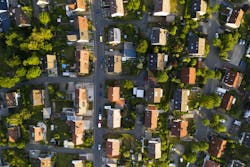The Case for Environmentally Sustainable FTTH Networks
Operators that integrate sustainability into fiber planning, deployment and operations gain more than a greener footprint—they gain a strategic edge in cost and performance.
Across industries, economic pressures have led many organizations to scale back sustainability initiatives. Yet for telecom operators, the path to a greener future is not only environmentally responsible but also financially advantageous. Fiber-to-the-home (FTTH) networks present a rare convergence of operational efficiency and carbon footprint reduction, offering long-term value in a volatile marketplace. One of the most compelling examples of this convergence is the stark difference in energy efficiency between FTTH and legacy broadband networks.
FTTH networks consume significantly less energy than legacy hybrid fiber coaxial (HFC) systems. . A recent report1 found that FTTH network operations generate up to 96% fewer carbon emissions compared to HFC networks. This dramatic reduction translates directly into cost savings, making sustainability not just a corporate social responsibility effort but a business imperative.
Moreover, fiber’s reliability means fewer service disruptions. This translates into reduced maintenance costs, fewer field technician dispatches and decreased fuel consumption for service vehicles. By minimizing unplanned maintenance events, operators also reduce customer churn, preserving revenue and brand reputation. However, the environmental case for FTTH isn’t limited to operational energy savings; it extends across the network’s entire life cycle.
FTTH networks, throughout their life cycle from production to deployment and operation, consistently outperform legacy networks in terms of energy efficiency and carbon footprint.
Environmental Concerns and Operational Efficiency
The environmental benefits of FTTH go beyond reduced carbon emissions. Fiber’s efficiency results in fewer active components, lower power consumption and more reliable performance over time. These factors together reduce operational overhead.
For instance, a recent white paper by the Fiber Broadband Association1 found that the carbon footprint of FTTH network operations is up to 96% lower than that of HFC networks, and installation emissions are 7% lower. Given the rising cost of energy, minimizing operational power usage directly impacts the bottom line. FTTH XGS-PON OLT technology, for example, generates just 0.42-0.83 kg CO₂e per home passed annually, compared to 11.38-11.53 kg CO₂e for HFC. Lower power consumption and fewer active components lead to significantly reduced electricity use. With energy prices continuing to rise, that’s a real competitive advantage.
To add a broader perspective, a 2024 study by Cartesian, commissioned by the FTTH Council Europe,2 underscores these benefits. It found that FTTH networks, throughout their life cycle from production to deployment and operation, consistently outperform legacy networks in terms of energy efficiency and carbon footprint. The study also highlights FTTH’s role in supporting the EU’s climate goals and the twin transitions of digitalization and sustainability.
In the United States, environmental, social and governance (ESG) frameworks3 are also driving telecom operators to rethink infrastructure strategies. US-based investors, regulators and institutional funds increasingly factor ESG metrics into decision-making. While adoption varies by region, national telecoms recognize that aligning with ESG goals can improve access to capital, attract sustainability-minded investors and demonstrate long-term operational resilience. Turning these environmental and strategic goals into operational reality requires smarter, data-driven network planning and deployment practices.
The Role of Precision GIS Planning
Building a sustainable FTTH network requires more than just selecting fiber over copper or coaxial. It requires a strategic approach to network planning, design and deployment. Precision fiber network planning, supported by digital tools, ensures that environmental and operational efficiencies are embedded from the outset. Geospatial information system (GIS) planning tools have emerged as a cornerstone of sustainable FTTH deployment. These platforms enable operators to:
- Optimize routing using existing infrastructure, minimizing new trenching and excavation.
- Rapidly model multiple deployment scenarios to select the most sustainable and cost-effective approach.
- Incorporate real-world factors like terrain and local infrastructure to avoid costly and disruptive rework.
This kind of precision in network planning lays the foundation for sustainable growth as operators move into new, often more challenging markets. The adoption of GIS in FTTH deployment is accelerating, driven by the escalating demand for gigabit broadband and government digitalization initiatives. GIS tools are instrumental in market analysis, network planning, engineering and maintaining network inventories. These tools also improve collaboration between field crews and office-based planners, reducing errors and streamlining operations.
Once the FTTH networks are deployed, the way they’re operated and maintained becomes the next critical factor in minimizing environmental impact.
Smarter Operations
Ongoing maintenance significantly impacts an FTTH network’s environmental and financial footprint. Smart operations shift maintenance from reactive to proactive, enhancing sustainability. Remote diagnostics and predictive maintenance tools detect issues early so operators can resolve problems without field visits. Emerging technologies are making this proactive, low-impact operational model increasingly achievable.
New AI-powered visual automation technologies are redefining how telecoms manage quality and compliance. These systems process video and image data captured in the field to validate installation quality, track construction milestones and flag deviations in real time. Automating these inspections improves first-time-right rates, eliminates unnecessary truck rolls and ensures data-driven maintenance cycles that reduce cost and emissions.
Unlike traditional reactive models, AI-enhanced network operations rely on proactive issue detection, dynamic updates to network inventory and improved documentation. These capabilities enable better capital planning and support ESG reporting through verifiable performance metrics. As the industry continues evolving, such tools will be essential for keeping sustainability and operational discipline aligned.
Automation enhances resource allocation. Digital workflows ensure that crews are dispatched only when needed and equipped with accurate information. This reduces delays, minimizes waste and improves efficiency. Smarter operations, enhanced by AI-powered technology, also extend network asset life. Fewer replacements mean lower capital expenditures and less environmental impact over time. Operational improvements like these have a direct bearing on telecom’s ability to meet ESG criteria and secure sustainable financing.
Fiber’s reliability means fewer service disruptions. This translates into reduced maintenance costs, fewer field technician dispatches and decreased fuel consumption for service vehicles. By minimizing unplanned maintenance events, operators also reduce customer churn, preserving revenue and brand reputation.
Sustainable Finance and ESG
The sustainability credentials of FTTH are no longer just environmental, they are increasingly financial.4 As investors, regulators and policymakers emphasize ESG criteria, FTTH networks are being recognized as green infrastructure assets, qualifying for sustainable finance and favorable investment terms. This financial alignment is supported by FTTH’s operational efficiency and its role in enabling equitable digital access, both of which advance broader societal and policy goals.
As ESG frameworks gain traction, particularly in the U.S., telecom operators are integrating sustainability metrics into corporate reporting and infrastructure strategies. Federal broadband and infrastructure initiatives are beginning to prioritize projects that align with ESG principles, rewarding operators that demonstrate carbon reduction, digital inclusion and long-term operational resilience.
To capture these financial, operational and environmental benefits, operators need clear, actionable sustainability roadmaps that embed ESG considerations across network planning, deployment and operations. This positions FTTH not just as a connectivity solution but as a strategic investment in sustainable infrastructure.
Strategic Next Steps for Telecom Operators
To realize FTTH’s sustainability and efficiency potential, operators should adopt full-life cycle strategies:
- GIS-based planning to integrate real-world data, optimize routes and reduce environmental impact.
- Automated design tools to reduce material waste and deployment time.
- AI-enhanced smart operations to reduce emissions, enable predictive maintenance and improve resource use.
- ESG integration to position FTTH as a green asset and improve stakeholder engagement.
Look for partners with interoperable, scalable and field-proven solutions that support practical sustainability goals. Together, these measures form a practical framework for telecom operators aiming to future-proof their networks while meeting environmental expectations.
As expectations around sustainability continue to rise, telecom operators must look beyond short-term fixes. FTTH networks provide a practical way to improve efficiency, reduce emissions and meet financial objectives in a single move. Success will depend on integrating technology, planning tools and ESG frameworks into a unified strategy. Those who move early will gain a lasting competitive edge in an industry where resilience and responsibility increasingly shape market value.
REFERENCES
1. Fiber Broadband Association report, https://fiberbroadband.org/wp-content/uploads/2024/07/FBA-059_Sustainability_WhitePaper_FIN.pdf
2. FTTH Council Europe study, https://www.ftthcouncil.eu/resources/all-publications-and-assets/2314/fibre-networks-as-green-assets-the-role-of-sustainable-finance
3. ASUENE Blog, https://asuene.com/us/blog/connecting-sustainability-esg-trends-in-the-telecommunications-industry
4. Analysys Mason article, https://www.analysysmason.com/consulting/articles/fibre-sustainability-credentials/
About the Author

Jay Cadman
Senior Vice President, Enterprise, IQGeo
Jay Cadman is Senior Vice President, Enterprise, at IQGeo. He has over 25 years’ experience in successfully building B2B technology sales and marketing organizations. He has worked in large multi-nationals, as well as start-ups in North America, Europe and Asia including GE Smallworld, Ubisense, and IQGeo.
Jay has successfully led entry and expansion in telecommunications, utilities, manufacturing, aerospace, and military markets internationally and specializes in building high performance highly motivated teams.
For more information, visit www.iqgeo.com. Follow IQGeo on LinkedIn, X and YouTube.
